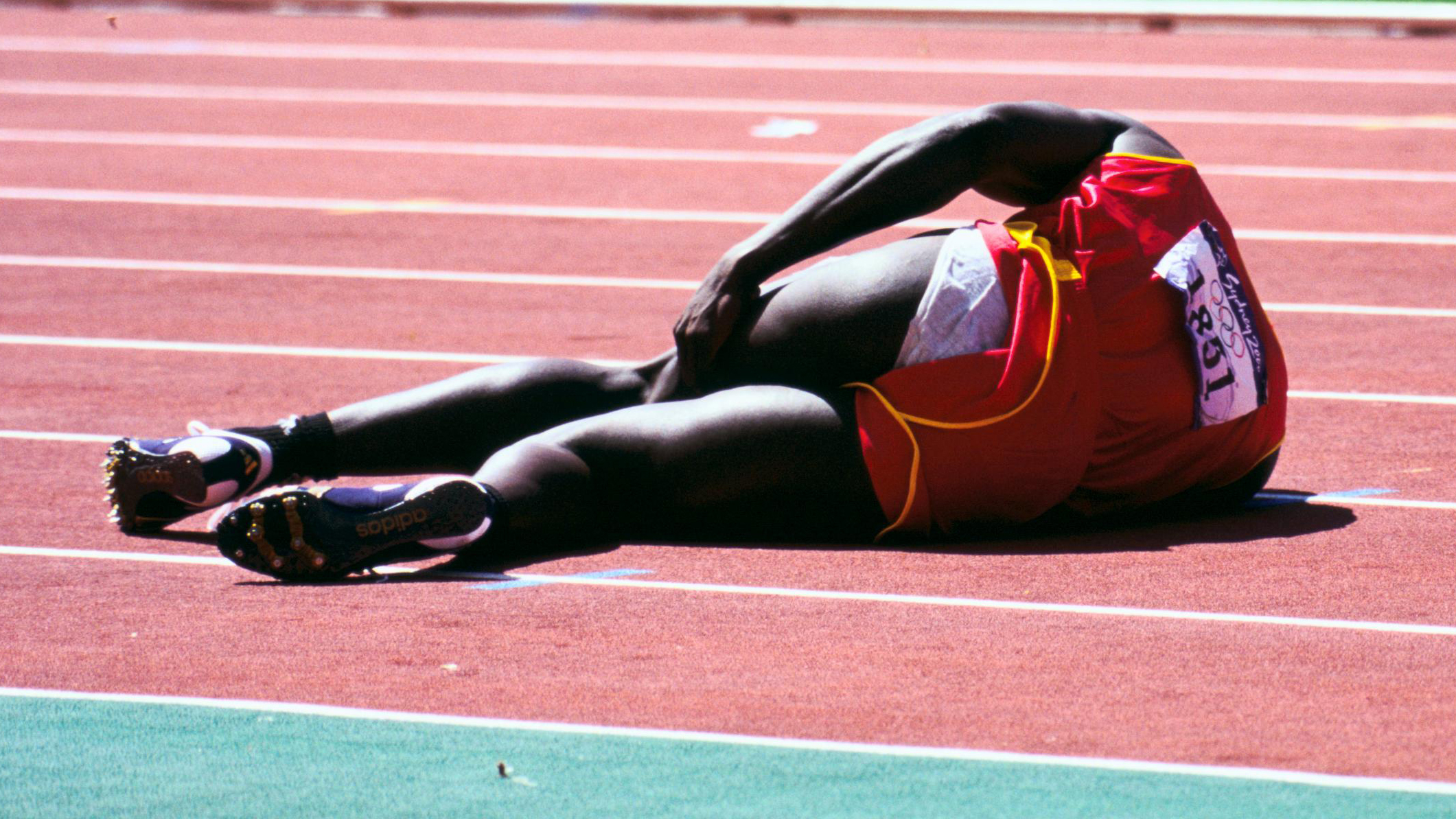Hamstring strain (pulled hamstring)
A hamstring strain is the most common acute sports injury that doesn't involve any body contact. Athletes in sports with fast acceleration, such as football and athletics are particularly vulnerable.

A strain involves a tear in some of the muscle fibres. In technical terms, this is known as a rupture. The hamstring group consists of three muscles on the back of the thigh. A strain in these muscles can come in many varieties and levels of severity. There is great variation in how long it will take before the athlete can return to sport.
Hamstrings
The muscles in the posterior part of the thigh are commonly known as the hamstrings. It is the collective term for the three muscles: biceps femoris, semimembranosus, and semitendinosus.
Injury types and mechanism
The most common type of hamstring strain injury is called a sprinting injury and occurs when running at high speeds. The hamstring tears as it produces power in an eccentric movement.
Another type of injury is a so-called 'stretching injury'. It occurs when the hip and knee joints are moved to an extreme outward position. This injury can occur, for example, during a high kick or a sliding tackle with the hip bent. This leads to the hamstrings being subjected to a large amount of stretching. Stretching injuries can also occur at slow speeds, for example when a ballet dancer stretches.
Sprinting injuries most often occur in the junction between the tendon and the muscle biceps femoris. Stretching injuries usually occur in the actual tendon. When the injury is located where the tendon and the muscle connect, it is easier to heal.
Risk factors
The most documented risk factor for a hamstring strain is a previous hamstring injury. This increases the risk by a factor between 5 and 10. The risk also increases with age. Decreased mobility, reduced muscle strength (eccentric muscle strength in particular) or reduced strength in relation to the anterior thigh muscles (the quadriceps) are also factors that could potentially carry a risk. However research results here is conflicting.
Signs and symptoms
A hamstring strain is usually characterised by the acute onset of pain, almost like a slash on the back of the thigh. When this happens, it is important to immediately reduce or completely stop whatever activity was being performed. The athlete typically grasps the posterior side of the thigh.
An athlete with a hamstring strain can no longer run as normal, and stretching the muscle can be painful. The injured area and surrounds will also feel tender when pressure is applied.
Diagnosis
A doctor or a physiotherapist will confirm the diagnosis using a clinical examination. Examinations using imaging techniques are not usually required, but may be necessary in rare cases. For example, if the doctor suspects a full rupture of the muscle (completely torn in two), or an avulsion fracture (when a bone fragment detaches from where the muscle is attached).
In certain sports at the elite level, MRI is still frequently used to uncover exactly where the injury is located and how severe it is. It appears, however, that it is not as useful as previously thought when it comes to predicting how long it will take before an athlete can return to sport.
Treatment
The great majority of hamstring injuries can be treated without surgery, and at this point there is no criteria for how to operate a hamstring strain.
One should commence acute treatment according to the PRICE principle immediately following the time of injury. After this, it is important to follow a structured rehabilitation program where the focus is to minimise scar tissue and stimulate healing. The aim is to regain as close to normal muscle length, muscle strength and control. Massage and other passive treatment techniques can reduce the symptoms, but should only be used in addition to the treatments listed above. Anti-inflammatory medications, such as Voltaren and Neurofen, should be avoided.
NSAIDs
Anti-inflammatory medications (NSAIDs), such as Voltaren and Neurofen, are not recommended as they can hinder the body's natural healing processes.
Rehabilitation
It is important to adapt and adjust the rehabilitation program according to the individual's needs, but below is a suggestion that can serve as a basic structure.
Specific exercises
A few days after the injury, the injured person can usually begin with small contractions of the affected muscles. This should not cause pain and the leg should not be moved. In technical terms this is known as isometric contractions. The purpose is to stimulate the healing process. Recent research has demonstrated that eccentric exercises (where the hamstring muscles are actively extended) that do not cause pain can have a positive effect.
Eccentric training
Eccentric movements are when the muscles are extended while loaded.
Strength training as prevention
Strength training is important both for preventing and rehabilitating hamstring injuries (read more about injury prevention below). Later on in the rehabilitation process, emphasis should be placed on eccentric strength exercises.
Exercises for the hamstring muscles should also involve the hip and knee, as the hamstring muscles are connected to these joints. In order to optimise hamstring function, exercises that focus on agility, hip and knee control as well as stabilising the hip are recommended.
Running is important
In addition to specific hamstring exercises, it is important to start with running and running-specific exercises early on. This is particularly important for athletes who wish to return to sports that involve sprinting. However, it is important that the progression is gradual and without pain. Even if the pain often decreases quickly following an injury, it is important to remember that the healing process is in early stages and the muscles will therefore not tolerate maximum loading. As such, it is crucial to gradually increase sport-specific training exercises in order to reduce the risk of re-injury.
Return to sport
There is a lot of individual variation in the time it takes to return to sport following a hamstring injury. Therefore, it is important to get a precise diagnosis but it usually in the vicinity of 1-6 weeks, longer if the muscles are torn all the way through.
The outcome is better for sprinting injuries than stretching injuries (both are described above). In order to avoid re-injury, the athlete should continue with specific hamstring exercises long after returning to sport, even if they feel that they are completely healed. The risk of re-injury increases if the athlete returns to regular sporting activities too early.
Prevention
Eccentric hamstrings training has been shown to have a substantial preventive effect. Studies have demonstrated that following a 10-week program of the nordic hamstrings exercise is incredibly effective at preventing strain injuries. A football team that follows this program can reduce the number of injured players by a third. Just remember to set aside time for rest, especially at the start.
The main factor for the effectiveness of such an injury prevention training program is that the athletes actually do complete the exercises. This means that trainers, parents (for younger athletes) and medical support have an important role in making sure this is done. Read more about the nordic hamstrings exercise below.


